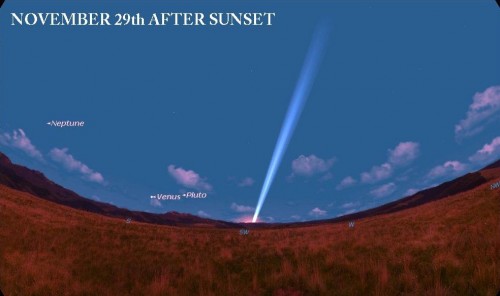Comet Ison has already stirred up the blogosphere and social media, and as always in matters of astronomy, the reality will be much milder

Two relatively bright comets are expected to approach the Earth in 2013. The first is the comet PANSTARRS which is expected to arrive in March, and may pass in brightness the comet Hale Bop which is visible to the naked eye (and I still remember the observation at Shafim Beach, AB) in 1996 But another comet, 2012/S1 or ISON is today the hot name on social networks such as Twitter, Facebook and Google Plus.
The reason: first calculations of its orbit show that it will pass very close to the Sun in November 2013. According to the calculations, it is expected to pass at a distance of less than 2 million kilometers from the Sun. This means that it may eject dust and gas trapped inside it when the ice that makes up a significant percentage of its mass evaporates and will therefore appear bright at the time, before being transported back into deep space.
In a framed article, there is a lot of nonsense going around on the internet, from people who don't understand even basic amateur astronomy on their first day, and make absurd arguments such as the claim that is repeated every year that Mars will be as big as the moon on August 27th.
However, experts in the field, including Stuart Atkinson, who writes a guest column in Universe Today, recommend to calm down and not expect an event of lighting a torch in the sky that will look like a strong light bulb (brightness minus 16, it is written in some cases - very strong brightness).
Although Comet Ison looks promising, it is still too early to predict what it will look like. Many observations of it are needed before we know exactly what it holds, and even then it is still difficult to predict long in advance what it will look like. Comets are unreliable, they have disappointed before and many of those we thought would be visible to the naked eye were barely visible with binoculars.
You have to remember that these are big chunks of dirty ice and we only see them because of the melting ice that causes them to emit fragments as they orbit the sun.
That's why the range of possibilities is wide, on the one hand, there is a chance, although not high, that it will be seen in the sky like in the special effects of science fiction movies, that its tail will stretch along half the sky and become visible as soon as the sun sets, and we can go outside and gather for viewing and photography.
At the other end of the rainbow, there are quite a few chances that it will fool us, and break into pieces even before it approaches the sun without developing a glowing tail, and we may be able to see its remains through binoculars. Most likely we will get something in the middle - let's hope that Ison will remain intact, survive the approach to the sun and shine in the evening sky next November, like previous comets such as Lovejoy or McNutt. But Abejoy was revealed only to viewers in the southern half of the earth. McNutt could indeed be seen in the north as well, but when he got there he could only be viewed through binoculars. If Ison succeeds in passing the Sun, then at least it will be possible to observe it - with the naked eye or through binoculars - depending on its actual brightness - from the northern skies, including from Israel.

5 תגובות
Read on Wikipedia and relax:
http://en.wikipedia.org/wiki/C/2012_S1
I'm in a panic - I can't keep quiet anymore and I have to share it with everyone!
C2012 - ISON discovered on 21.10.2012 will pass through the Earth's orbit if and when its orbit changes slightly
It is expected to approach the Earth at the end of November this year - estimated November 26-28!
What do the astronomers say? Disagreement!
I checked and found countless places on the net where the comet is mentioned, but in all the places there is no mention of any scenario in which the comet will change its course, which is most likely to happen.
Can anyone reassure me?
It was seen yesterday in the sky, can someone perhaps try to explain these two rays?
http://www.mobli.com/droramitay/20043966/i-actually-stopped-surfing-to-run-to-the-car-and-s
Thanks for the correction, it was my mistake due to a moment of lack of concentration. Of course, I myself wrote several articles about this nonsense of August 27.
A Mars stretch refers to August 27, not March